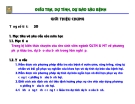


Meloidogyne
•Vào cu i 2004, 106 loài đã ố
đ c mô tượ ả
•Phân b r r r ng ố ấ ộ
•N i ký sinh b t bu c trong ộ ắ ộ
rễ

Đ c đi m chung ặ ể
•Gây h i quan trong nh t trong các nhóm ạ ấ
TT
•M t ộs loài ký sinh trên 2,000 lo i th c ố ạ ự
v tậ
•T o "ạĐ i bàoạ" trong rễ
•T o ạb u trên rướ ễ
•Sinh s n đ n tính (parthenogenesis?) ả ơ
•Tr ng đ c đ ra ngoài c th , trong m t ứ ượ ẻ ơ ể ộ
túi nh n (gelatinous matrix sac)(có th nhìn ờ ể
th y trên b m t r ) 500 - 1000 w/con ấ ề ặ ễ


![Công nghệ tổng hợp etylen: [Thông tin chi tiết/Mới nhất/Tối ưu]](https://cdn.tailieu.vn/images/document/thumbnail/2012/20121107/huyenhoa5/135x160/5141353913599.jpg)












![Bài tập Đa dạng thế giới sống [kèm đáp án/ hướng dẫn giải]](https://cdn.tailieu.vn/images/document/thumbnail/2025/20251123/thaohoang9203@gmail.com/135x160/5861763951302.jpg)











